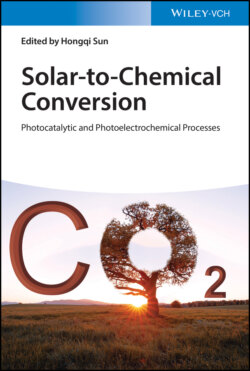Читать книгу Solar-to-Chemical Conversion - Группа авторов - Страница 23
2.4.1.6 Other Hydrocarbons
ОглавлениеApart from these hydrocarbons produced in CO2 photoreduction with high frequency, some complicated hydrocarbons with more than two carbon numbers have been reported recently. Fusco et al. reported firstly the formation of C2 hydrocarbons, acetic acid, through CO2 photoreduction over TiO2@PEI‐grafted‐MWCNTs hybrids under UV–Vis light irradiation [63]. Besides, Park et al. decorated Cu nanoparticles and CdS quantum dots on the surface of TiO2 nanotubes, forming a ternary nanostructured photocatalyst that is capable of converting CO2 and H2O into C1–C3 hydrocarbons, including CH4, C2H6, C3H6, and C3H8 (Figure 2.12b–e) [64]. In this system, CdS quantum dots are responsible of harvesting solar light and forming hot electrons that will rapidly move to Cu nanoparticles through TiO2 nanotubes. At Cu nanoparticles, the concentrated electrons can react with CO2 molecular and produce CxHy under visible‐light excitation (above 420 nm), as shown in Figure 2.12a. In contrast, over five hours irradiation, free H2 molecular that is more easily formed than CO2 reduction products was not detected, which inferred that competitive H2 evolution reaction has been suppressed efficiently in this CdS/(Cu–TNTs) hybrid system. The photocatalytic reduction of CO2 over the CdS/(Cu–TNTs) hybrid is initiated likely through a one‐electron reduction to form ˙CO2−, reacting in turn with a H atom (H·) to produce hydrocarbons (Figure 2.12f). CO2 hydrogenation leading to hydrocarbon formation appears to be a less likely pathway because of the absence of H2 detected in the headspace of the photolysis reactor during five hours of irradiation with visible light. However, the yield and efficiency are sharply decreased owing to involvement of more electrons, formation of longer C–C chains, and production of more by‐products, which severely undermine the proportion of expected products, such as C3 or C4 hydrocarbons. Therefore, to increase the formation possibility and efficiency of major hydrocarbons, electrocatalytic CO2 reduction is paid attention through introducing more strong hot electrons to react with adsorbed CO2 molecular over a variety of electrocatalysts, leading to longer carbon chain hydrocarbons [65].
Figure 2.12 (a) Scheme of the photocatalytic CO2 reduction over CdS/(Cu–NaxH2−xTi3O7) irradiated by light. (b) Gas evolution rates of C1–C3 hydrocarbons on CdS/(Cu–NaxH2−xTi3O7) as well as the specific surface area, where the Na/Ti ratios were 0.093 (low), 0.143 (medium), and 0.507 (high). (c–e) Mass spectra of the formed hydrocarbons (methane, ethane, and propane) with the labeling of 13C. (f) Proposed elementary reaction mechanisms of photocatalytic CO2 conversion into hydrocarbons.
Source: Park et al. [64].
